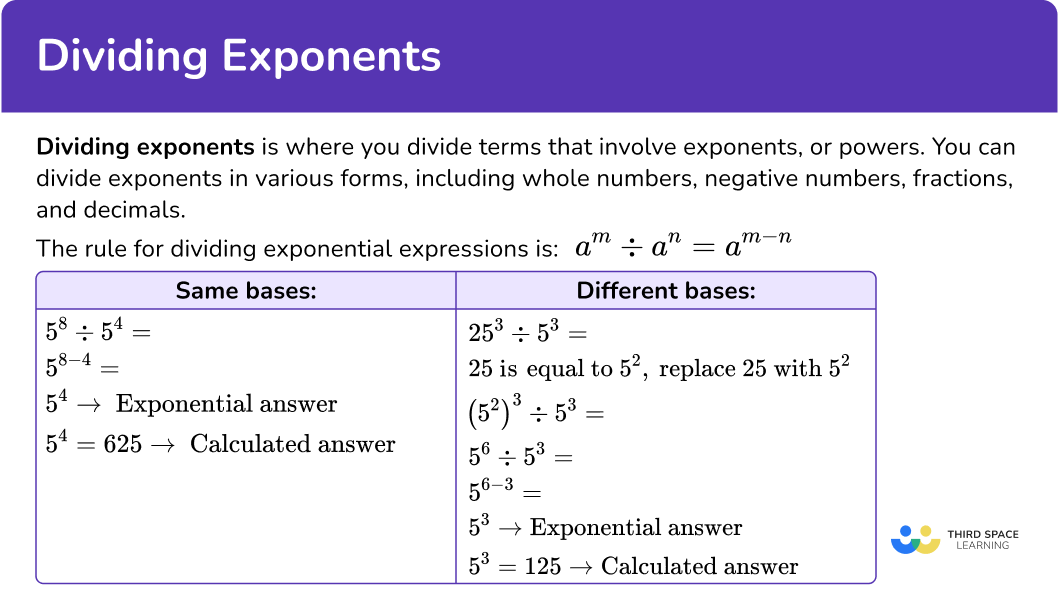
Here you will learn about dividing exponents, including how to use the laws of exponents to divide exponents and how to divide exponents that have different bases.
Students will first learn about dividing exponents as a part of expressions and equations in 8 th grade math, and will continue to expand on the knowledge throughout high school.
Dividing exponents is where you divide terms that involve exponents, or powers. You can divide exponents in various forms, including whole numbers, negative numbers, fractions, and decimals.
When dividing numerical or algebraic expressions that have the same base, you can subtract the exponents.
You can rewrite the division problem in expanded form,
There are seven 8’ s on the top and four 8’ s on the bottom. So, the expression can be simplified to be:

This is equivalent to \cfrac=8^3
Another way to think about it is to subtract exponents.
What happens if the bases are not the same?
If the bases of the exponential expression are not the same, before calculating an answer, try to rewrite the expression so the bases are the same.
Let’s try to rewrite 9^4 so that it has a base of 3.
9 is the same as 3^2
Replace 9 with 3^2 in the original expression.
\left(3^2\right)^4 \div 3^4=
This is the same as,
3^2 \times 3^2 \times 3^2 \times 3^2, which is 3^8 \div 3^4
Now the bases are the same, so you can subtract exponents.
Let’s look at one more example.
Since the bases are the same, you can subtract exponents.
![[FREE] Algebra Check for Understanding Quiz (Grade 6 to 8)](https://thirdspacelearning.com/wp-content/uploads/2023/07/Algebra-check-for-understanding-quiz-listing-image-.png)
![[FREE] Algebra Check for Understanding Quiz (Grade 6 to 8)](https://thirdspacelearning.com/wp-content/uploads/2023/07/Algebra-check-for-understanding-quiz-listing-image-.png)
Use this quiz to check your grade 6 – grade 8 students’ understanding of algebra. 10+ questions with answers covering a range of 6th to 8th grade algebra topics to identify areas of strength and support!
![[FREE] Algebra Check for Understanding Quiz (Grade 6 to 8)](https://thirdspacelearning.com/wp-content/uploads/2023/07/Algebra-check-for-understanding-quiz-listing-image-.png)
![[FREE] Algebra Check for Understanding Quiz (Grade 6 to 8)](https://thirdspacelearning.com/wp-content/uploads/2023/07/Algebra-check-for-understanding-quiz-listing-image-.png)
Use this quiz to check your grade 6 – grade 8 students’ understanding of algebra. 10+ questions with answers covering a range of 6th to 8th grade algebra topics to identify areas of strength and support!
*bases must be the same

How does this relate to 8 th grade math – algebra?
In order to divide exponents with the same base, you will:
Simplify and leave your answer in index form.
Subtract the exponents 5 and 2.
2 Divide any coefficients of the base variables.
Because the coefficients are 1,
Simplify and leave your answer in index form.
Subtract the exponents.
Subtract the exponents 9 and 2.
Divide any coefficients of the base variables.
Divide the coefficients 21 and 7.
Simplify and leave your answer in index form.
Subtract the exponents.
Subtract the powers -6 and the -4.
Divide any coefficients of the base variables.
Divide the coefficients 18 and the 9.
Remember to change negative exponents to positive exponents.
Simplify and leave your answer in index form.
Subtract the exponents.
Subtract the exponents \cfrac and \cfrac.
Remember, to subtract fractions, find a common denominator.
Divide any coefficients of the base variables.
Because the coefficients are 1,
In order to divide exponents when the bases are different, you will:
Rewrite the expressions that can have matching bases.
4 can be rewritten to be 2^2. So, you can replace 4 with 2^2
\left(2^2\right)^2 \div 2^3=2^4 \div 2^3=
Subtract the exponents of the expressions with matching bases.
Since the bases are the same, you can subtract the exponents.
Work out any of the other calculations and simplify.
In exponential form, the answer is 2^2.
The calculation is:
8^2 \div 2^4 \div 3^2
Rewrite the expressions that can have matching bases.
8^2 \div 2^4 \div 3^2
8 is the same as 2^3. So, you can replace 8 with 2^3.
\left(2^3\right)^2 \div 2^4 \div 3^2
2^6 \div 2^4 \div 3^2=
Subtract the exponents of the expressions with matching bases.
Subtract the exponents of the exponential expressions with the same bases.
\begin & 2^6 \div 2^4 \div 3^2= \\\\ & 2^ \div 3^2= \\\\ & 2^2 \div 3^2= \end
Work out any of the other calculations and simplify.
In exponential form, the answer is 2^3 \div 3^2
The calculation is:
2^2 \div 3^2=4 \div 9=\cfrac=0 . \overline
1) Simplify the expression. Express your answer in exponential form.












63a^ \div 7 a^ = 9a
(When the power is 1, you do not need to write it.)








Rewrite the expression so that the bases are the same.
27 is the same as 3^3. So, you can replace 27 with 3^3.
\begin & 27^2 \div 3^3= \\\\ & \left(3^3\right)^2 \div 3^3= \end
![]()
You can apply the rule and subtract exponents.




There is no possibility to rewrite the terms so they have the same bases. So, perform the calculations.
\begin 3^&=3 \times 3 \times 3 \times 3=81\\\\ 2^&=\cfrac=\cfrac \end
\begin 3^ \div 2^ &= 81 \div \cfrac\\\\ &=81 \times 4\\\\ &=324 \end
An exponent is a small number that is written above and to the right of a number, known as the base number. This indicates how many times a number is multiplied by itself (repeated multiplication).
For example, 2^4, 2 is the base number and 4 is the exponent.
What is the negative exponent rule?The negative exponent rule is, for any nonzero number a and any integer n, a^ is equal to \cfrac. Taking a negative exponent is equivalent to finding the reciprocal of the corresponding positive exponent.
Can you divide exponents that are fractions or decimals?Yes, you can still apply the rules of exponents when dealing with exponential expressions that involve decimal or fractional exponents.
For example, \cfrac> =x^3 \div x^>=x^>=x^>. You will subtract the exponent in the denominator from the exponent in the numerator.
What is the quotient of powers rule?The quotient of powers rule states that when dividing exponent with the same base, subtract the exponents.
At Third Space Learning, we specialize in helping teachers and school leaders to provide personalized math support for more of their students through high-quality, online one-on-one math tutoring delivered by subject experts.
Each week, our tutors support thousands of students who are at risk of not meeting their grade-level expectations, and help accelerate their progress and boost their confidence.

Find out how we can help your students achieve success with our math tutoring programs.
Prepare for math tests in your state with these 3rd Grade to 8th Grade practice assessments for Common Core and state equivalents.
Get your 6 multiple choice practice tests with detailed answers to support test prep, created by US math teachers for US math teachers!
Third Space Learning Inc, 3 Germay Dr, Unit 4 #2810, Wilmington 19804

© 2024 Third Space Learning. All rights reserved.
Third Space Learning is the trading name of Virtual Class Ltd
We use essential and non-essential cookies to improve the experience on our website. Please read our Cookies Policy for information on how we use cookies and how to manage or change your cookie settings.Accept
Privacy & Cookies PolicyThis website uses cookies to improve your experience while you navigate through the website. Out of these, the cookies that are categorized as necessary are stored on your browser as they are essential for the working of basic functionalities of the website. We also use third-party cookies that help us analyze and understand how you use this website. These cookies will be stored in your browser only with your consent. You also have the option to opt-out of these cookies. But opting out of some of these cookies may affect your browsing experience.
Always EnabledNecessary cookies are absolutely essential for the website to function properly. This category only includes cookies that ensures basic functionalities and security features of the website. These cookies do not store any personal information.
Non-necessaryAny cookies that may not be particularly necessary for the website to function and is used specifically to collect user personal data via analytics, ads, other embedded contents are termed as non-necessary cookies. It is mandatory to procure user consent prior to running these cookies on your website.